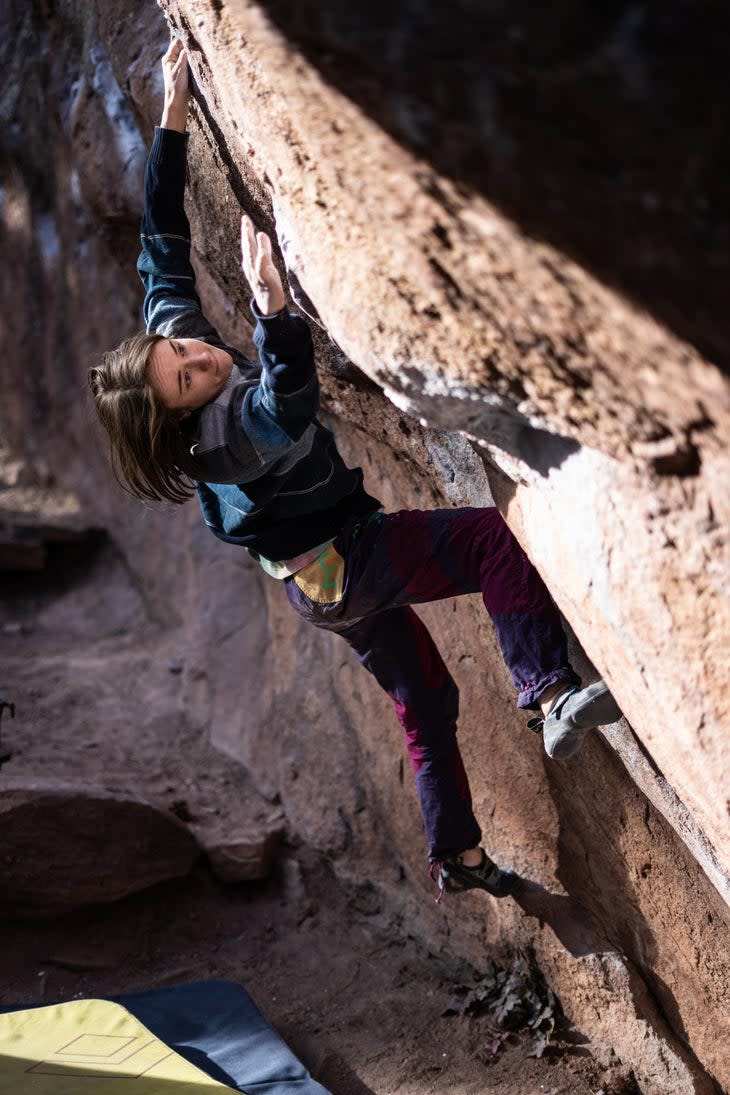An Ode to Traverses
This article originally appeared on Climbing
One move from the finish jug, I threw my right foot high and wide, placing it onto a toaster-oven-shaped block. Fresh, I could do the final dynamic throw every time. After 50 feet of unroped climbing and several minutes on the wall, my fingers were uncurling. From the ground, I'd moved through gently overhung sandstone on thin, angling crimps that had pushed the limits of my finger strength. I’d skipped the last bail-out point and matched on the thin rail before the final jug. Now, with wooden arms, I lunged. As my hand shot towards the thank-God hold, my right foot slipped. The jug disappeared as I plummeted towards my pads, three feet below the Upper Y Traverse (V3+) at Flagstaff Mountain, just outside of Boulder, Colorado.
Climbing is generally assumed to be an upward sport. You start at the bottom and the route ends when you reach the top. That's certainly one way of going about it, but lately I've discovered the joys of climbing sideways.
Long boulder traverses form a distinct sub-discipline in climbing. Fontainebleau even uses a separate grading system for traverses. While appearing the same on paper, the difficulty ramps up more gradually to reflect the endurance nature of the lines. A traditional Font 5A would be considered Hueco V1, while a Font traverse 5A lands at V0. On the upper end of the scale, the difference is more pronounced. An upwards 9A is V17, while a sideways 9A is a more achievable V13. Similar to Font's circuits, which enchain boulders to simulate longer mountain routes, traverses are a way to maximize climbing volume on a limited resource. Some make traverses their primary pursuit, like the French climber Jean-Pierre Bouvier. In 2012, the 55-year-old completed the first ascent of Fou Rire (Aller-Retour), creating a 9A line by climbing the Fou Rire traverse out and then back again on Font’s Cuisiniere Crete Sud boulder. Aller-retour translates to "round trip."
Boulder traverses appeal to me because they allow me to try hard moves even closer to the ground. It's the concept of bouldering distilled further. I can attempt Bishop's Iron Man Traverse (V4) without taking on much risk, and try Flagstaff's Underclimb Traverse (V9) without throwing a V9 move 10 feet off the deck. I'd even suggest that many cutting edge boulder problems are traverses. If you're climbing across a roof, without climbing up, that's a traverse, right? Chris Sharma's Catalan Witness the Fitness (V14 or V15, depending who you ask) looks more sideways than up to me. Same goes for the original Witness the Fitness (V15), Horizon (V15), Wheel of Life (V15), Hydrangea (V15/16), and Creature from the Black Lagoon (V16). Sure, most of those problems top out. But so does the Upper Y Traverse.

Similar to sport climbs, long boulder traverses provide climbers with a high volume of moves. However, due to their proximity to the ground, they're more accessible than roped routes. I was able to dial in the beta on Upper Y Traverse without boinking up a rope, finding a belayer, or fiddling with a toprope solo setup. As a 5.10 climber, to work a sport route that difficult, I'd have to go bolt to bolt and burn through thirty belayers. Long boulder traverses, like sport routes, involve a lot of climbing and a lot of beta. One of the difficulties on Upper Y was identifying a near no-hands rest in the center of the line. The first time I squatted on my right knee and flagged onto a divot to remove my hands, I teetered off and landed on my back. The second time I made small adjustments and shook out. The problem taught me to find and learn to use the rest, a skill that transfers to sport climbing but isn't often trained on boulder problems. That's not to say that traverses don't have their own logistical challenges. With just three pads to cover a 50-foot problem, I needed to be selective about what I would protect. On my redpoint burns, I placed one pad over a back-breaking block behind the first-half crux. The other two protected the topout. I had to be comfortable above the bare ground for the rest. Three feet off the deck is reasonable, but a friend of mine did shatter his heal hitting a jagged rock from that height.
* * *
Traverses aren't strictly for the timid, though. Girdle traverses are quite the opposite. Distinct from ridge traverses, which climb up and down features en route to a summit--or in some cases a chain of summits, like Peter Croft's monster Evolution Traverse--girdle traverses climb sideways along the width of a cliff face. These can be enormous endeavors. In 1987, at New York's Shawnagunks, where routes rarely surpass three pitches, Ken Nichols and then-Access Fund president Dave Rosenstein traversed the Trapps below the Grand Traverse ledge via The Great Wall of China (5.9 R), a 67-pitch behemoth. The reportedly unrepeated route features long runouts that would result in dangerous swings, but stays within a ropelength of the ground throughout. The likely crux, though, comes in navigating around other parties as you climb across the perpetually crowded cliff, a common difficulty on traverses like Great Wall or the (5.13b) traverse across the popular Gallery at Red Rock.
While crowds can prevent attempts on girdle traverses, the shear enormity of them will deter most. "The Girdle is not El Cap’s best route but it climbs many of El Caps finest pitches. It is also not the worst route ...," wrote Chris McNamara of El Capitan's longest route, a 75-pitch VI 5.10 A4 route that's twice the length of the Nose. Over five days in 1998 McNamara and Mark Melven completed the left to right line. "In the end the Girdle was just what we expected it to be: long, obscure, and most of all adventurous."
Read: Here Are 4 Massive Girdle Traverses
While the Great Wall of China and the Girdle Traverse log serious mileage, the title for longest traverse in North America goes to Mount Yamnuska's All McConnell's Fault (5.11 A0) in Alberta, Canada. Allan Derbyshire and Choc Quinn completed the 88 pitch, mile and a half long rock climb in 2004. The line, however, never saw a continuous ascent and was only climbed in sections. Mark Bramble attempted to climb the route in a single 24 hour push but was unsuccessful. Instead, he became the first to climb the route in sections in a year.
* * *
I rolled up to the Upper Y boulder for my next session straight from the dentist, my whole mouth numb with novocaine. I was the only one at the wall, which is usually crowded with teenagers posing for Instagram photos. I dropped my pads, warmed up by climbing the easier second half, and rehearsed the rest position. I pulled on the start holds and then sent. It didn't feel dramatic; I was just climbing sideways three feet off the ground. And that's the whole point. I can get more out of the line in the future by trying to reverse it, running laps, or even going for the round trip ascent. For now, I've moved onto the Monkey Traverse (V4) across the street. I have the beta sorted and can climb most the problem in three sections, which are separated by no hands rests. I'll need to put in more work before I can link sections, and there are still a few hard moves I haven’t done yet: the topout.
Also read:
For Safety's Sake, Don't Do This: Take The Leader Off Belay While Still Climbing
How Climbing Saved Cedar Wright and Lucho Rivera From Their Downward Spirals
For exclusive access to all of our fitness, gear, adventure, and travel stories, plus discounts on trips, events, and gear, sign up for Outside+ today.


